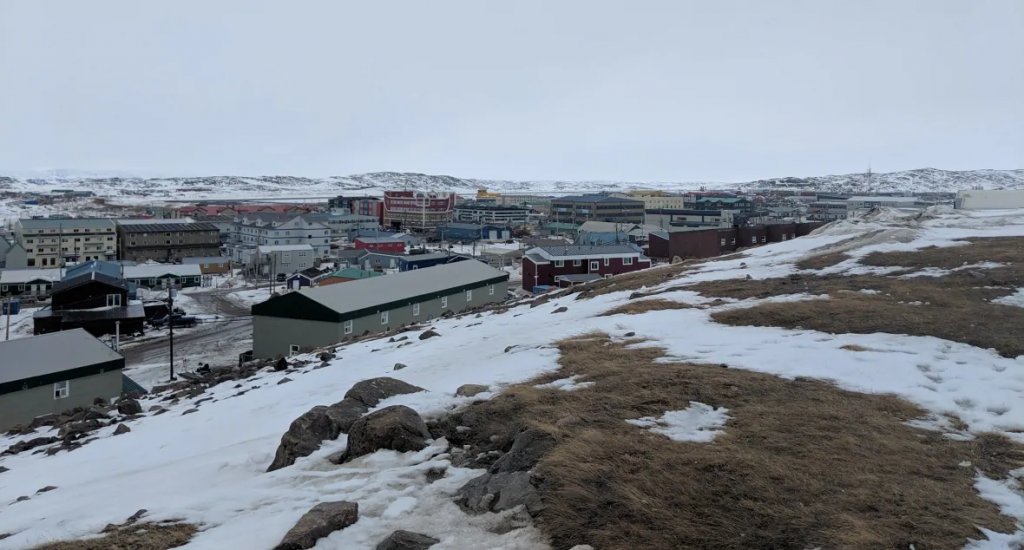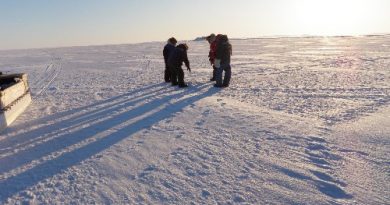Arctic Canadian city of Iqaluit sets record high temperature for Jan. 19, reaching 0.5 C

If Iqalummiut feel like winter has been especially mild this year, they’re not wrong.
Temperatures have been unseasonably balmy by Iqaluit standards this winter and Tuesday officially had the warmest maximum temperature recorded for Jan. 19 since records began in 1946 at 0.5 C. The previous warmest Jan. 19 was in 1958 at -2.2 C, according to Environment Canada.
Thursday didn’t quite break a record for having the mildest minimum temperature, though it was about 15 C warmer than the average low. Environment Canada says the low for Thursday was about -15 C, compared to the average low for Jan. 21, which is around -32 C.
The record for the warmest high for Jan. 21 was set in 1958 at 3.9 C, says David Phillips, a senior climatologist with Environment Canada. This Thursday’s high was at least 0.5 C.
Phillips says this week’s warm weather pattern carries on a trend that’s been seen since late November.
Last December, he said, tied for the second warmest on record in the last 75 years.
“I mean it’s like a different world. If that’s not a heat wave then I don’t know what is,” Phillips said.
“That’s something that is quite exceptional and as I say, you’ve got temperatures this week that are like a dozen to two dozen degrees warmer than they should be for this time of the year.”
‘Relentless’ warmth
Phillips says it’s alarming how long this warm spell has lasted.
If the rest of this month continues on a warm streak, Phillips says December and January’s average temperatures will be the warmest on record.
He adds that what’s exceptional is not the odd warm days necessarily, but the relentlessness of the warmth.
“It’s almost [like] this cold weather has been missing in action,” Phillips said. “It’s going on week after week.”
He says from October 2020 to Jan. 19, there should have been at least 21 days by now where temperatures dipped to around -30 C, but so far there have only been four of those days. And there should have been about 53 days so far where the temperature was below -20 C, but there have only been 34.
Southern air
Phillips says these temperatures can be explained by a low pressure area to the South that is acting like a heat pump that is “pumping this southerly … mild air right into the Arctic.”
And it’s been going on since late November, throughout December and into January.
“I mean, it would be cold by … southern standards, but certainly not by the North,” Phillips said.
But whether these oddly warm days can solely be attributed to climate change is tough to answer in the Arctic, he explained, since there are many factors to look at.
“This is where climate change is staring you in the face,” he said. “In the South, we wonder if we’re seeing climate change at all.”
In the high Arctic, that’s another story, he says.
“You can look out your window and see climate change, the ice disappearing … the permafrost is not what it used to be, it’s not as deep — you’re seeing, clearly, evidence of a runaway kind of climate.”
In any case, he says it’s consistent with what can be expected in the future.
“It’s almost like a … dress rehearsal for something you’re going to see more of in the years to come as the climate really warms up in the North,” he said.
That’s not to say those “brutal, cold” days with “face-numbing wind chills” won’t happen either.
“There’ll be moments of that. There always is,” he said, though added in 20 to 30 years, the extremes of warm and cool spells will be more normal.
When temperatures do cool off, Phillips says it will just be to what is normally expected this time of year.
‘People are wondering where it’s winter’
It’s not just Iqaluit experiencing an unusual winter either.
Phillips says he’s looked at temperatures across the entire Arctic and “they’re all balmy.”
“They’re all much milder, maybe 10 to 12 degrees, maybe not as dramatic as Iqaluit, but they clearly are several, several degrees warmer than you’d expect for this time of the year,” he said, adding it’s a trend beyond the North too.
“People are wondering where it’s winter. And and I think the circulation is such that we’re seeing much more southerly air, more American air.”
Related stories from around the North:
Canada: Top 5 weather stories in the Canadian North for 2020, CBC News
Finland: Lapland temperature of -39 C marks year’s coldest day so far in Finland, Yle News
Greenland: Rise in sea level from ice melt in Greenland and Antarctica match worst-case scenario: study, CBC News
Russia: Russia has never been this hot, The Independent Barents Observer
Sweden: Reducing emissions could create up to 3,000 new jobs in Arctic Sweden says mining group, Eye on the Arctic
United States: November ranks 2nd hottest on record for the Arctic and globe, Radio Canada International
-Written by Amy Tucker, with files from Jackie McKay



